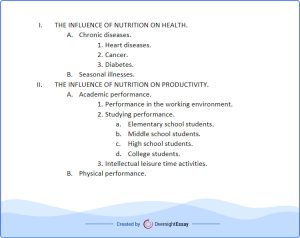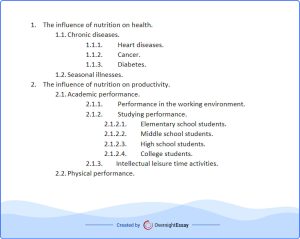23 Outlining
In the past, you have probably made an outline before you began to write. Making the outline helps you move from 1.) getting ideas to 2.) deciding how you will organize those ideas.
- Step One: Gather (or think of) a number of ideas.
- Step Two: Make an outline–a plan for exactly which ideas you will include and how you will organize them.
The second way you will use outlining in ESL 116 is to increase your understanding of a text that you are reading. This is sometimes called “reverse outlining” since the text has already been written. It is the reader who creates an outline in order to analyze the text effectively.
Whether you are making an outline before you write or making a reverse outline of an article, there are different formats you can use. Notice that all of these formats indicate the organization of ideas as well as relationships between general (main ideas) and specific (supporting details).
Examples: Outline formats



You may want to use one of these types of outline or an an entirely different format for reverse outlining; for example:
THESIS:
Katniss Everdeen, the heroine of “The Hunger Games,” creates as much danger for herself as she faces from others over the course of the film.
MAIN IDEAS and HOW THEY SUPPORT THE THESIS
Main Idea ¶ 1: She volunteers to fight in the games.
This is the root of most of the immediate danger she finds herself in, so her directly volunteering to do it definitely helped put her in front of that danger.
Main Idea ¶ 2: Shooting the apple out of the pig’s mouth.
This draws more attention to her and essentially puts a target on her back that the other…

